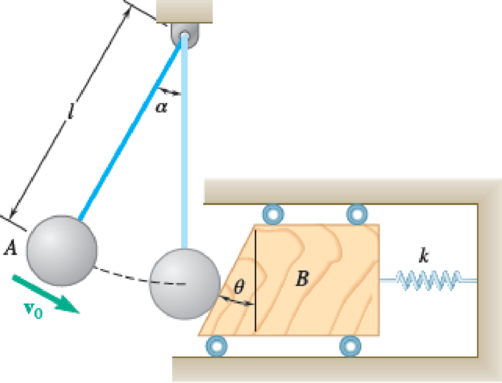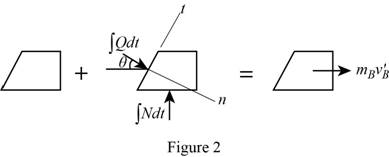
When the rope is at an angle of α = 30°, the 1-lb sphere A has a speed v0 = 4 ft/s. The coefficient of restitution between A and the 2-lb wedge B is 0.7 and the length of rope l = 2.6 ft. The spring constant has a value of 2 lb/in. and θ = 20°. Determine (a) the velocities of A and B immediately after the impact, (b) the maximum deflection of the spring, assuming A does not strike B again before this point.

(a)
Find the velocity of A
Answer to Problem 13.188P
The velocity of A
Explanation of Solution
Given information:
The angle of the rope
The weight of the sphere A
The weight of the wedge B
The speed of the sphere A
The coefficient of restitution between A and wedge (e) is 0.7.
The length of the rope (l) is
The spring constant (k) is
The angle
The acceleration due to gravity (g) is
Calculation:
Calculate the mass of sphere A
Substitute
Calculate the mass of wedge B
Substitute
Calculate the initial altitude of sphere
Substitute
Calculate the initial potential energy of sphere
Substitute
Calculate the initial kinetic energy of sphere
Here,
Substitute
Calculate the altitude of sphere just before impact
Substitute
Calculate the initial potential energy of sphere just before impact
Substitute
Calculate the kinetic energy of sphere just before impact
Here,
Substitute
The expression for the principle of conservation of energy between initial and final stage of sphere as follows:
Substitute
Show the impulse-momentum diagram for sphere as in Figure (1).

The expression for the momentum in tangential direction as follows:
Here,
Substitute
Show the impulse-momentum diagram of wedge as in Figure (2).

The expression for the momentum in x-direction as follows:
Here,
Substitute
Calculate the coefficient of restitution (e) using the formula:
Substitute 0.7 for e,
Find the velocity of sphere B immediately after the impact:
Substitute
Find the normal component of velocity of sphere:
Substitute
Calculate the resultant velocity of sphere A
Substitute
Calculate the angle for
Substitute
Calculate the resultant angle of velocity of sphere A
Substitute 63.77 for
Therefore, the velocity of A
(b)
Find the maximum deflection of the spring assuming A does not strike B again before this point.
Answer to Problem 13.188P
The maximum deflection of the spring
Explanation of Solution
Given information:
The angle of the rope
The weight of the sphere A
The weight of the wedge B
The speed of the sphere A
The coefficient of restitution between A and wedge (e) is 0.7.
The length of the rope (l) is
The spring constant (k) is
The angle
The acceleration due to gravity (g) is
Calculation:
Calculate the kinetic energy of wedge block just before impact
Here,
Substitute
The expression for the potential energy of spring at the end of impact
The expression for the principle of conservation of energy for wedge block as follows:
Here,
Substitute
Substitute
Therefore, the maximum deflection of the spring
Want to see more full solutions like this?
Chapter 13 Solutions
Vector Mechanics for Engineers: Statics and Dynamics
- A ball of negligible size and mass m is given a velocity of v0 on the center of the cart which has a mass M and is originally at rest. If the coefficient of restitution between the ball and walls A and B is e, determine the velocity of the ball and the cart just after the ball strikes A. Also, determine the total time needed for the ball to strike A, rebound, then strike B, and rebound and then return to the center of the cart. Neglect frictionarrow_forwardDirect central impact occurs between a 100lbs body moving to the right at 5 ft per second and a body of weight W moving to the left at 3 ft per sec. The coefficient of restitution e = 0.5. After impact the 100lb body rebounds to the left at 2ft/s. Determine the weight W of the other body. (lbs)arrow_forward: The Balls A and B are of the same size and each is attached to a 1 m cable as shown. The mass of A is 2 kg and the mass of B is 1 kg. The Ball A is released from rest with a 40o angle with the vertical direction as shown. Determine the speed of the Ball B right after the impact if the coefficient of restitution is e = 0.5. Assume the Ball B is at rest before the Ball A hits it.arrow_forward
- The two disks A and B have a mass of 4 kg and 6 kg , respectively. They collide with the initial velocities shown. The coefficient of restitution is e = 0.65. Suppose that (vA)1 = 6 m/s , (vB)1 = 7 m/s Determine the magnitude of the velocity of A just after impact. Determine the angle between the x axis and the velocity of A just after impact, measured clockwise from the negative x axis. Determine the magnitude of the velocity of B just after impact. Determine the angle between the x axis and the velocity of B just after impact, measured clockwise from the positive x axis.arrow_forwardThe three balls each weigh 0.4 lb and have a coefficient of restitution of e = 0.75. If ball A is released from rest and strikes ball B and then ball B strikes ball C, determine the velocity of each ball after the second collision has occurred. The balls slide without friction. Please explain the stepsarrow_forwardThe 12-lb box slides on the surface for which μk = 0.3. The box has a velocity v = 15 ft/s when it is 2 ft from the plate. a) If the box strikes the smooth plate, which has a weight of 22 lb and is held in position by an unstretched spring of stiffness k = 440 lb/ft, determine the maximum compression imparted to the spring. Take e = 0.8 between the box and the plate. Assume that the plate slides smoothly. x = ?arrow_forward
- The 10-lb collar B is at rest, and when it is in the position shown the spring is unstretched. If another 1-lb collar A strikes it so that B slides 4 ft on the smooth rod before momentarily stopping, determine the velocity of A just after impact, and the average force exerted between A and B during the impact if the impact occurs in 0.002 s. The coefficient of restitution between A and B is e = 0.5arrow_forwardThe 9.0 kg sphere A is held at an angle of 60° as shown, and then is released from rest and hits the B sphere which has a mass of 4.5 kg. In this crash the coefficient of restitution is e = 0.75. The sphere B is attached to the end of a rod lightweight rotating around the O point. The spring is initially non elongated and it is known that the maximum angle θ that the rod turned after the crash measured from the initial position was of 21.4º. Calculate: a) The speed with which sphere A impacts with sphere B. b) The magnitude and direction of the velocities of each sphere A and B after impact. c) The mechanical energy dissipated on impact. d) The spring stiffness constant k.arrow_forward4. The 12-kg package A has a speed of 2.5 m/s when it enters the smooth ramp. As it slides down the ramp, it strikes the 34-kg package B which is initially at rest. If the coefficient of restitution between A and Bis = 0.65, determine the velocity of B just after the impact.arrow_forward
- A 3 kg slider is released from rest at point A and slides with negligible friction' in a vertical plane along the circular rod. The attached spring has a stiffness of 350 N/m and has an unstretched length of 0.75 m. a) Which of the following gives the gravitational potential energy if the slider passes position B. b) Which of the following gives the elastic potential energy if the slider passes position B. c) Which of the following gives the velocity of slider as it passes position Barrow_forwardtube A expels a 0.5 kg ball with a horizontal velocity Va = 2 m / s. Determine the horizontal distance R at which the smooth inclined plane hits. If the coefficient of restitution is e = 0.6, determine how fast it bounces off the plane at B. Make the free-body diagramsarrow_forwardTwo smooth disks A and B have the initial velocities shown just before they collide at O. If they have masses m, 8 kg and my 6 kg, determine their speeds just after impact. The coefficient of restitution is e=0.5.arrow_forward
 Elements Of ElectromagneticsMechanical EngineeringISBN:9780190698614Author:Sadiku, Matthew N. O.Publisher:Oxford University Press
Elements Of ElectromagneticsMechanical EngineeringISBN:9780190698614Author:Sadiku, Matthew N. O.Publisher:Oxford University Press Mechanics of Materials (10th Edition)Mechanical EngineeringISBN:9780134319650Author:Russell C. HibbelerPublisher:PEARSON
Mechanics of Materials (10th Edition)Mechanical EngineeringISBN:9780134319650Author:Russell C. HibbelerPublisher:PEARSON Thermodynamics: An Engineering ApproachMechanical EngineeringISBN:9781259822674Author:Yunus A. Cengel Dr., Michael A. BolesPublisher:McGraw-Hill Education
Thermodynamics: An Engineering ApproachMechanical EngineeringISBN:9781259822674Author:Yunus A. Cengel Dr., Michael A. BolesPublisher:McGraw-Hill Education Control Systems EngineeringMechanical EngineeringISBN:9781118170519Author:Norman S. NisePublisher:WILEY
Control Systems EngineeringMechanical EngineeringISBN:9781118170519Author:Norman S. NisePublisher:WILEY Mechanics of Materials (MindTap Course List)Mechanical EngineeringISBN:9781337093347Author:Barry J. Goodno, James M. GerePublisher:Cengage Learning
Mechanics of Materials (MindTap Course List)Mechanical EngineeringISBN:9781337093347Author:Barry J. Goodno, James M. GerePublisher:Cengage Learning Engineering Mechanics: StaticsMechanical EngineeringISBN:9781118807330Author:James L. Meriam, L. G. Kraige, J. N. BoltonPublisher:WILEY
Engineering Mechanics: StaticsMechanical EngineeringISBN:9781118807330Author:James L. Meriam, L. G. Kraige, J. N. BoltonPublisher:WILEY





